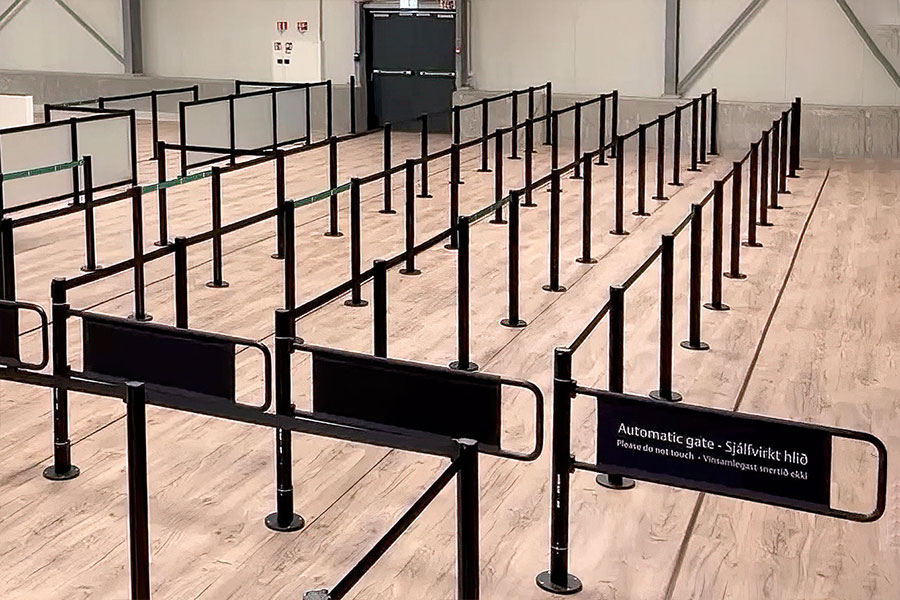
Queue & A: Expert Advice for Keeping High-Volume Queues Safe and Efficient
Crowds come together in all sorts of environments. From casinos, amusement parks, and concert halls, to transportation hubs, festivals, and sports venues: What unique challenges and opportunities exist when designing high-volume queues?
With more than 18 years of expertise, Perry Kuklin, director of marketing at Lavi Industries discusses how queue systems for supersized spaces can be optimized for speed, safety, and satisfaction.
The Queue Takes Centerstage
Consider this: When Madison Square Garden first opened in 1890, it featured a modest hall with a capacity of 1,500. Today, the venue can hold more than 20,000 sports fans and concertgoers.
“Since 9/11, more thought has gone into where and how you wait. Queues are now more structured than ever,” Perry explains. “There’s emphasis on greater safety and greater equity, with more service points and staff working together to load balance.”
5 Must-Knows For High-Volume Queue Design
“Besides speed and safety, there’s a big monetary incentive to move as many people as quickly as possible through the queue—because more time beyond security means more money spent on concessions and merchandise.”
Perry shares his approach that helps clients work through the challenge of designing a large-crowd queue management system that’s safe, efficient, and profitable.
1. Start with safety and compliance.

Tragic events like stampedes, fires, and critical delays in emergency response over the last few decades underscore the severe consequences of inadequate crowd management. To address these issues, planning for emergency situations is now non-negotiable for large venues. One of the first considerations in design? “Understand how people can egress in emergencies—which directions they can go,” Perry says.
After that, it’s about choosing the right queuing products. Perry notes, “Recently, businesses have been focusing on ensuring that customer queue systems meet Americans with Disabilities Act (ADA) compliance standards and receive fire marshal approval.”
It could be as simple as putting up double-belted stanchions that provide a cane-detectable barrier to assist individuals with visual impairment. Or maybe it’s choosing reflective, high-visibility belt colors for safety in low-light conditions. Airports often incorporate egress gates, offering quick evacuation routes in response to medical emergencies, potential terror threats, or crowd surges. The bottom line? Safety first.
2. Plan for different fill levels.

Understanding peak times and ensuring that your system can accommodate them is the second order of business once safety has been established. “Consider operational data—how many people are you servicing and when?" Perry explains.
Lavi’s modular system allows for quick reconfiguration to adapt to changing crowd sizes and flow patterns. Components are easily expanded or rearranged to fit different layouts and capacity needs—which is why it’s the system for Harry Reid International Airport’s TSA Innovation Checkpoint, which serves up to 166,000 passengers a day.
It’s also worth considering portable products that can be effortlessly incorporated into customer queue management systems to provide greater flexibility during sudden crowd surges. For instance, in busy retail areas, mobile gondolas roll out to extend and entertain. At airports or festival grounds, wheeled JetTrac barriers instantly add 125 feet in any direction, enhancing order and safety.
3. Incorporate technology early.

Perry explains, “We integrate technology in many ways—during the planning and layout phases, we use 3D drawing software to place the queue and products in actual size in the space, so you’ll see the system in the exact environment.” This approach allows clients to visualize how the queue will function and make adjustments before installation.
Technology also plays a crucial role in the actual operation of queues. “Smart guidance systems and electronic queuing systems are some of the tools we use to optimize flow and efficiency,” Perry says. These advancements ensure that queue systems are not only well-designed but also adapt in real-time to enhance the overall user experience.
4. Redefine the wait experience.

Research shows that even brief waits of 10-30 minutes can significantly impact perceived value.
Electronic queuing's digital signage feature helps reduce perceived wait times, improving the customer experience.
“Queues are living, breathing entities,” Perry emphasizes. With smart guidance systems, we’re able to monitor all service points and fill levels in real time. Smart gates dynamically adjust to direct traffic along optimal pathways—balancing service loads, maintaining steady passenger flow, and optimizing layouts in time. This orchestration improves wait times and creates a less stressful environment for customers.
5. Don’t forget signage.

Signage is often overlooked in large-scale queues. "Directional signage needs to be where people can see it," Perry emphasizes. At checkpoints in concert venues, museums, stadiums, and transportation hubs, he recommends using a combination of high-visibility overhead and eye-level ground signs.
“An efficient queue starts before a person even gets in that queue. What lane should they be getting into for their particular need? Do they understand how the lanes are organized?”
To remedy this, Perry’s team often uses a combination of queue-integrated panel signage with overhead signs, positioned at about seven feet tall, to ensure that they’re in the line of sight without being blocked. He adds, “We often use color coding on signs and retractable belts to maintain clarity, consistency, and confidence through the queue, reminding passengers which line they’re in as they move forward.”
If you need guidance on designing efficient, safe, and compliant queue systems for large venues, talk to the experts at Lavi Industries.
SUBSCRIBE
Subscribe to stay up-to-date with new products, resources information and news.
RECENT RESOURCES
Theft at the Register: How Strategic Queue Design Protects Profits
ViewRapid Deployment Crowd Control: JetTrac Portable Barriers For The Biggest Spaces
View4 Psychological Reasons Your Customers Hate Waiting In Line
ViewFrom Bleachers To Bookstores: 4 Campus Crowd Control Solutions
View








